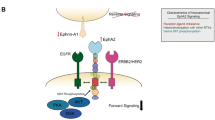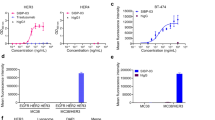Abstract
The ErbB receptors, such as ErbB-1 and ErbB-2, have been intensely pursued as targets for cancer therapeutics. Although initially efficacious in a subset of patients, drugs targeting these receptors led invariably to resistance, which is often associated with reactivation of the ErbB-3-PI3K-Akt signaling. This may be overcome by an ErbB-3 ligand that abrogates receptor-mediated signaling. Toward this end, we have generated a mouse monoclonal antibody, MP-RM-1, against the extracellular domain (ECD) of ErbB-3 receptor. Assessment of human tumor cell lines, as well as early passage tumor cells revealed that MP-RM-1 effectively inhibited both NRG-1β-dependent and -independent ErbB-3 activation. The antagonizing effect of MP-RM-1 was of non-competitive type, as binding of [125I]-labeled NRG-1β to ErbB-3 was not influenced by the antibody. MP-RM-1 treatment led, in most instances, to decreased ErbB-3 expression. In addition, MP-RM-1 was able to inhibit the colony formation ability of tumor cells and tumor growth in two human tumor xenograft nude mouse models. Treatment with the antibody was associated with a decreased ErbB-3 and Akt phosphorylation and ErbB-3 expression in the excised tumor tissue. Collectively, these results indicate that MP-RM-1 has the potential to interfere with signaling by ErbB-3 and reinforce the notion that ErbB-3 could be a key target in cancer-drug design.
This is a preview of subscription content, access via your institution
Access options
Subscribe to this journal
Receive 50 print issues and online access
$259.00 per year
only $5.18 per issue
Buy this article
- Purchase on Springer Link
- Instant access to full article PDF
Prices may be subject to local taxes which are calculated during checkout







Similar content being viewed by others
References
Alimandi M, Romano A, Curia MC, Muraro R, Fedi P, Aaronson SA et al. (1995). Cooperative signaling of ErbB3 and ErbB2 in neoplastic transformation and human mammary carcinomas. Oncogene 10: 1813–1821.
Anastasi S, Sala G, Huiping C, Caprini E, Russo G, Iacovelli S et al. (2005). Loss of RALT/MIG-6 expression in ERBB2-amplified breast carcinomas enhances ErbB-2 oncogenic potency and favors resistance to Herceptin. Oncogene 24: 4540–4548.
Baselga J, Swain SM . (2009). Novel anticancer targets: revisiting ERBB2 and discovering ERBB3. Nat Rev Cancer 9: 463–475.
Baulida J, Kraus MH, Alimandi M, Di Fiore PP, Carpenter G . (1996). All ErbB receptors other than the epidermal growth factor receptor are endocytosis impaired. J Biol Chem 271: 5251–5257.
Bianchi S, Palli D, Falchetti M, Saieva C, Masala G, Mancini B et al. (2006). ErbB-receptors expression and survival in breast carcinoma: a 15-year follow-up study. J Cell Physiol 206: 702–708.
Chen L, Siddiqui S, Bose S, Mooso B, Asuncion A, Bedolla RG et al. (2010). Nrdp1-mediated regulation of ErbB3 expression by the androgen receptor in androgen-dependent but not castrate-resistant prostate cancer cells. Cancer Res 70: 5994–6003.
Citri A, Yarden Y . (2006). EGF-ERBB signalling: towards the systems level. Nat Rev Mol Cell Biol 7: 505–516.
Di Fiore PP, Pierce JH, Fleming TP, Hazan R, Ullrich A, King CR et al. (1987a). Overexpression of the human EGF receptor confers an EGF-dependent transformed phenotype to NIH 3T3 cells. Cell 51: 1063–1070.
Di Fiore PP, Pierce JH, Kraus MH, Segatto O, King CR, Aaronson SA . (1987b). erbB-2 is a potent oncogene when overexpressed in NIH/3T3 cells. Science 237: 178–182.
Digiesi G, Giacomini P, Fraioli R, Mariani M, Nicotra MR, Segatto O et al. (1992). Production and characterization of murine mAbs to the extracellular domain of human neu oncogene product GP185HER2. Hybridoma 11: 519–527.
Engelman JA, Zejnullahu K, Mitsudomi T, Song Y, Hyland C, Park JO et al. (2007). MET amplification leads to gefitinib resistance in lung cancer by activating ERBB3 signaling. Science 316: 1039–1043.
Fiorini M, Ballaro C, Sala G, Falcone G, Alema S, Segatto O . (2002). Expression of RALT, a feedback inhibitor of ErbB receptors, is subjected to an integrated transcriptional and post-translational control. Oncogene 21: 6530–6539.
Franklin MC, Carey KD, Vajdos FF, Leahy DJ, de Vos AM, Sliwkowski MX . (2004). Insights into ErbB signaling from the structure of the ErbB2-pertuzumab complex. Cancer Cell 5: 317–328.
Giampaglia M, Chiuri VE, Tinelli A, De Laurentiis M, Silvestris N, Lorusso V . (2010). Lapatinib in breast cancer: clinical experiences and future perspectives. Cancer Treat Rev 36 (Suppl 3): S72–S79.
Gschwind A, Fischer OM, Ullrich A . (2004). The discovery of receptor tyrosine kinases: targets for cancer therapy. Nat Rev Cancer 4: 361–370.
Hynes NE, Lane HA . (2005). ERBB receptors and cancer: the complexity of targeted inhibitors. Nat Rev Cancer 5: 341–354.
Hynes NE . (2007). Targeting ERBB receptors in cancer. Recent Results Cancer Res 172: 45–57.
Hynes NE, MacDonald G . (2009). ErbB receptors and signaling pathways in cancer. Curr Opin Cell Biol 21: 177–184.
Ishikawa N, Daigo Y, Takano A, Taniwaki M, Kato T, Hayama S et al. (2005). Increases of amphiregulin and transforming growth factor-alpha in serum as predictors of poor response to gefitinib among patients with advanced non-small cell lung cancers. Cancer Res 65: 9176–9184.
Karamouzis MV, Badra FA, Papavassiliou AG . (2007). Breast cancer: the upgraded role of HER-3 and HER-4. Int J Biochem Cell Biol 39: 851–856.
Kraus MH, Fedi P, Starks V, Muraro R, Aaronson SA . (1993). Demonstration of ligand-dependent signaling by the erbB-3 tyrosine kinase and its constitutive activation in human breast tumor cells. Proc Natl Acad Sci USA 90: 2900–2904.
Lee-Hoeflich ST, Crocker L, Yao E, Pham T, Munroe X, Hoeflich KP et al. (2008). A central role for HER3 in HER2-amplified breast cancer: implications for targeted therapy. Cancer Res 68: 5878–5887.
Leonetti C, D′Agnano I, Lozupone F, Valentini A, Geiser T, Zon G et al. (1996). Antitumor effect of c-myc antisense phosphorothioate oligodeoxynucleotides on human melanoma cells in vitro and and in mice. J Natl Cancer Inst 88: 419–429.
Liu B, Ordonez-Ercan D, Fan Z, Edgerton SM, Yang X, Thor AD . (2007). Downregulation of erbB3 abrogates erbB2-mediated tamoxifen resistance in breast cancer cells. Int J Cancer 120: 1874–1882.
Mendelsohn J, Baselga J . (2006). Epidermal growth factor receptor targeting in cancer. Semin Oncol 33: 369–385.
Mottolese M, Venturo I, Donnorso RP, Curcio CG, Rinaldi M, Natali PG . (1988). Use of selected combinations of monoclonal antibodies to tumor associated antigens in the diagnosis of neoplastic effusions of unknown origin. Eur J Cancer Clin Oncol 24: 1277–1284.
Natali PG, Nicotra MR, Di Renzo MF, Prat M, Bigotti A, Cavaliere R et al. (1993). Expression of the c-Met/HGF receptor in human melanocytic neoplasms: demonstration of the relationship to malignant melanoma tumour progression. Br J Cancer 68: 746–750.
Piccolo E, Innominato PF, Mariggio MA, Maffucci T, Iacobelli S, Falasca M . (2002). The mechanism involved in the regulation of phospholipase Cgamma1 activity in cell migration. Oncogene 21: 6520–6529.
Prewett M, Rothman M, Waksal H, Feldman M, Bander NH, Hicklin DJ . (1998). Mouse-human chimeric anti-epidermal growth factor receptor antibody C225 inhibits the growth of human renal cell carcinoma xenografts in nude mice. Clin Cancer Res 4: 2957–2966.
Prigent SA, Gullick WJ . (1994). Identification of c-erbB-3 binding sites for phosphatidylinositol 3′-kinase and SHC using an EGF receptor/c-erbB-3 chimera. EMBO J 13: 2831–2841.
Rege-Cambrin G, Scaravaglio P, Carozzi F, Giordano S, Ponzetto C, Comoglio PM et al. (1992). Karyotypic analysis of gastric carcinoma cell lines carrying an amplified c-met oncogene. Cancer Genet Cytogenet 64: 170–173.
Reschke M, Mihic-Probst D, van der Horst EH, Knyazev P, Wild PJ, Hutterer M et al. (2008). HER3 is a determinant for poor prognosis in melanoma. Clin Cancer Res 14: 5188–5197.
Romond EH, Perez EA, Bryant J, Suman VJ, Geyer Jr CE, Davidson NE et al. (2005). Trastuzumab plus adjuvant chemotherapy for operable HER2-positive breast cancer. N Engl J Med 353: 1673–1684.
Sala G, Dituri F, Raimondi C, Previdi S, Maffucci T, Mazzoletti M et al. (2008). Phospholipase Cgamma1 is required for metastasis development and progression. Cancer Res 68: 10187–10196.
Saxena R, Dwivedi A . (2010). ErbB family receptor inhibitors as therapeutic agents in breast cancer: Current status and future clinical perspective. Med Res Rev (e-pub ahead of print).
Schoeberl B, Faber AC, Li D, Liang MC, Crosby K, Onsum M et al. (2010). An ErbB3 antibody, MM-121, is active in cancers with ligand-dependent activation. Cancer Res 70: 2485–2494.
Schoeberl B, Pace EA, Fitzgerald JB, Harms BD, Xu L, Nie L et al. (2009). Therapeutically targeting ErbB3: a key node in ligand-induced activation of the ErbB receptor-PI3K axis. Sci Signal 2: ra31.
Sergina NV, Rausch M, Wang D, Blair J, Hann B, Shokat KM et al. (2007). Escape from HER-family tyrosine kinase inhibitor therapy by the kinase-inactive HER3. Nature 445: 437–441.
Shi F, Telesco SE, Liu Y, Radhakrishnan R, Lemmon MA . (2010). ErbB3/HER3 intracellular domain is competent to bind ATP and catalyze autophosphorylation. Proc Natl Acad Sci USA 107: 7692–7697.
Sithanandam G, Fornwald LW, Fields J, Anderson LM . (2005). Inactivation of ErbB3 by siRNA promotes apoptosis and attenuates growth and invasiveness of human lung adenocarcinoma cell line A549. Oncogene 24: 1847–1859.
Sunada H, Magun BE, Mendelsohn J, MacLeod CL . (1986). Monoclonal antibody against epidermal growth factor receptor is internalized without stimulating receptor phosphorylation. Proc Natl Acad Sci USA 83: 3825–3829.
Tanner B, Hasenclever D, Stern K, Schormann W, Bezler M, Hermes M et al. (2006). ErbB-3 predicts survival in ovarian cancer. J Clin Oncol 24: 4317–4323.
Wallasch C, Weiss FU, Niederfellner G, Jallal B, Issing W, Ullrich A . (1995). Heregulin-dependent regulation of HER2/neu oncogenic signaling by heterodimerization with HER3. EMBO J 14: 4267–4275.
Weinstein JN, van Osdol W . (1992). Early intervention in cancer using monoclonal antibodies and other biological ligands: micropharmacology and the ‘binding site barrier’. Cancer Res 52: 2747s–2751s.
Witton CJ, Reeves JR, Going JJ, Cooke TG, Bartlett JM . (2003). Expression of the HER1-4 family of receptor tyrosine kinases in breast cancer. J Pathol 200: 290–297.
Wu WK, Tse TT, Sung JJ, Li ZJ, Yu L, Cho CH . (2009). Expression of ErbB receptors and their cognate ligands in gastric and colon cancer cell lines. Anticancer Res 29: 229–234.
Yi ES, Harclerode D, Gondo M, Stephenson M, Brown RW, Younes M et al. (1997). High c-erbB-3 protein expression is associated with shorter survival in advanced non-small cell lung carcinomas. Mod Pathol 10: 142–148.
Zhou BB, Peyton M, He B, Liu C, Girard L, Caudler E et al. (2006). Targeting ADAM-mediated ligand cleavage to inhibit HER3 and EGFR pathways in non-small cell lung cancer. Cancer Cell 10: 39–50.
Acknowledgements
We thank Dr F Petronzelli (Sigma-Tau Pomezia, Italy) for the measurement of MP-RM-1 affinity by surface plasmonic resonance; Dr O Segatto, Dr S Anastasi and Dr M Sallese for advice and reagents, R La Sorda and MR Nicotra for the immunohistochemical analysis, Dr A Sala and Professor V De Laurenzi for discussion. PGN and MP partially supported by AIRC.
Author information
Authors and Affiliations
Consortia
Corresponding author
Ethics declarations
Competing interests
The authors declare no conflict of interest.
Additional information
Supplementary Information accompanies the paper on the Oncogene website
Rights and permissions
About this article
Cite this article
Sala, G., Traini, S., D'Egidio, M. et al. An ErbB-3 antibody, MP-RM-1, inhibits tumor growth by blocking ligand-dependent and independent activation of ErbB-3/Akt signaling. Oncogene 31, 1275–1286 (2012). https://doi.org/10.1038/onc.2011.322
Received:
Revised:
Accepted:
Published:
Issue Date:
DOI: https://doi.org/10.1038/onc.2011.322
Keywords
This article is cited by
-
HER3 in cancer: from the bench to the bedside
Journal of Experimental & Clinical Cancer Research (2022)
-
Osimertinib and anti-HER3 combination therapy engages immune dependent tumor toxicity via STING activation in trans
Cell Death & Disease (2022)
-
Targeting of erbB3 receptor to overcome resistance in cancer treatment
Molecular Cancer (2014)
-
Dual targeting of ErbB-2/ErbB-3 results in enhanced antitumor activity in preclinical models of pancreatic cancer
Oncogenesis (2014)
-
Therapeutic targeting of erbB3 with MM-121/SAR256212 enhances antitumor activity of paclitaxel against erbB2-overexpressing breast cancer
Breast Cancer Research (2013)



